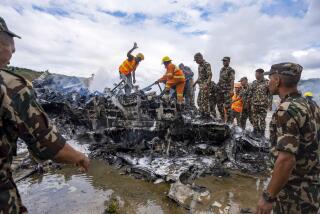Airline’s Fourth Crash : Air India Safety Questioned in the Past
- Share via
NEW DELHI — Sunday’s crash of an Air India Boeing 747 was the worst disaster in India’s civil aviation history and the fourth involving the country’s international flag carrier since the airline was established in 1953.
Questions regarding Air India’s safety procedures arose after two of the airline’s three previous crashes.
Air India Flight 182 plunged into the Atlantic Ocean on Sunday as it approached the Irish coast on a flight from Canada. Searchers found wreckage from the plane but no evidence of survivors among the 329 passengers and crew on board.
‘Really Unfortunate’
“It is sad, it is really unfortunate,” said Ashok Gehlot, minister of state for civil aviation. “It’s the worst that has happened in our civil aviation history.”
Aviation experts consider the Boeing 747 one of the safest planes in service. Of the 610 jumbo jets delivered since they started flying commercially in 1970, no more than two have crashed as a result of possible technical failures of the aircraft, said Jack Gamble, a spokesman for the Boeing Co. in Seattle. A total of 12 of the jumbo jets have been destroyed, many of them by terrorists.
Before Sunday, Air India’s most recent crash occurred on June 5, 1982, when one of its Boeing 707s crashed as it was approaching Bombay airport during a nighttime rainstorm. Seventeen people died.
Indian newspapers reported complaints at the time about inadequate safety and navigational aids at the nation’s airports.
Action Against Pilot
A court of inquiry said there had been a lack of coordination among the flight crew members and recommended “exemplary punitive action” against the pilot and corrective training for the co-pilot.
On Jan. 1, 1978, an Air India Boeing 747 plunged into the Arabian Sea after taking off from Bombay, killing 213 people.
In a case still pending, lawyers for the victims’ families filed a $100 million suit in U.S. District Court in Seattle, Boeing’s headquarters, alleging that a failure in the cockpit instrument panel gave the pilot false information and was responsible for the crash. The plaintiffs also alleged that the pilot was unfit to fly because he was diabetic and had been drinking at a New Year’s Eve party before the flight.
Air India’s first crash occurred on Jan. 24, 1966 when a Boeing 707 carrying 117 people slammed into Europe’s highest mountain, Mt. Blanc, on the border between France and Switzerland.
On Saturday, the Times of India reported that on April 19, an Air India Boeing 747 had arrived at Toronto with barely 1,980 pounds of fuel, instead of the recommended 11,000 pounds.
The paper quoted the airline as saying that the plane, which had been diverted from Montreal because of bad weather, landed at Toronto with 5,500 pounds of fuel, but consumed most of it in taxiing to the parking position.
Air India was established as a state-owned international carrier in 1953, six years after the country gained independence from Britain. It operates scheduled service to Europe, North America, Africa, Asia and Australia using a fleet of Boeing 747s and European-built Airbus 300s and 310s.
More to Read
Sign up for Essential California
The most important California stories and recommendations in your inbox every morning.
You may occasionally receive promotional content from the Los Angeles Times.













